Lung disease
Below is an overview and brief explanation of the most important diseases of the lungs and respiratory tract.
The lungs are responsible for the body's adequate intake and supply of oxygen. It consists of two spatially and functionally independent lungs and with these surrounds the heart. The two organs lie in common in the thorax (thorax), protected by the ribs.
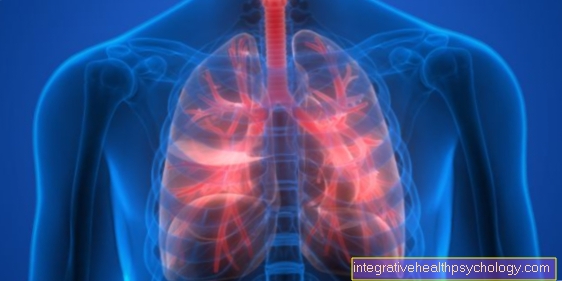
The diseases of the lungs
Below you will find an overview of the most common diseases and injuries of the lungs, broken down according to:
- Infection and inflammation
- Obstructive pulmonary disease
- Dysfunction and structural diseases of the lungs
- Rare lung diseases
Infection and inflammation

Pneumonia / pneumonia
Pneumonia is a relatively common but very serious condition. In particular, elderly and bedridden patients often develop pneumonia, which in the worst case can be fatal. Even with longer hospital stays, the risk of developing pneumonia increases. Pneumonia is usually triggered by pathogens such as the bacteria pneumococci. For bacterial pneumonia, antibiotic therapy is usually the method of choice.
For details, see Lung infection.
bronchitis
Bronchitis is an inflammation of the bronchi, the section of the airways that carries air from the windpipe into the end of the lungs. In contrast to pneumonia, bronchitis is usually caused by viruses. The current bronchitis usually heals within 1-2 weeks, to suppress the urge to cough, cough suppressants such as codeine drops can be used.
Smoking can cause chronic bronchitis, which can cause severe lung dysfunction and severely reduce life expectancy. (see also COPD)
For details, see Bronchitis.
Inflammation of the windpipe
An inflammation of the windpipe is a rarer inflammation of the airways, which usually occurs together with other symptoms in the area of the nasopharynx. It can be triggered by bacteria and viruses, but also by other substances that irritate the lining of the windpipe. This mainly includes cigarette smoke. Most patients suffer from a dry cough, hoarseness and general symptoms such as fever.
For details, see Inflammation of the windpipe.
pleurisy
The pleura or pleura ("Pleura") lines the rib cage from the inside and thus lies on the outside of the lungs. Inflammation of the pleura usually does not occur independently, but is a consequence or complication of another disease. For example, pneumonia can spread to the pleura. A pleurisy, medical pleurisy, is usually associated with severe pain, a feeling of sickness and, if necessary, difficulty breathing. The therapy is usually inpatient and includes an intensified dose of antibiotics. The pleura can also be affected as part of a cancer of the lungs.
Obstructive pulmonary disease

bronchial asthma
Bronchial asthma, in short asthma, is one of the obstructive pulmonary diseases. These so-called obstructions are characterized by the fact that patients have problems exhaling the air in the lungs due to narrowed / obstructed airways. The origin of asthma has not yet been conclusively clarified, there are many different triggers. In addition to genetic and environmental factors such as Particulate matter and cigarette smoke pollution, allergic influences in particular play a role. In general, there are extensive inflammatory reactions within the lungs that cause the airways to swell and narrow. In therapy, airway dilators (e.g. salbutamol) and anti-inflammatory sprays (e.g. cortisone) are used. But modern antibody-containing drugs are also playing an increasingly important role.
You can find detailed informaion under Bronchial asthma.
COPD
COPD stands for chronic obstructive pulmonary disease - in English "chronic obstructive pulmonary disease". It usually develops over a long period of time from chronic bronchitis and in over 90% of cases long-term cigarette consumption is the trigger for the disease. The diagnosis of COPD is made when a patient has had a chronic mucous cough for at least 3 months for 2 consecutive years. There is no cure for COPD; the aim of therapy is to stop the disease from progressing. Smoking should definitely be stopped for this. Medicines similar to those used for asthma can be used for symptoms, e.g. salbutamol / cortisone sprays.
For details, see COPD.
Emphysema
Pulmonary emphysema is an overinflation of an alveoli or part of a lung lobe. This overinflation usually occurs over the course of years as a result of a chronic lung disease such as COPD. In this case, the air remains in the emphysema and cannot be exhaled. Since this part of the lungs can no longer take part in the oxygen supply and becomes functionless, patients suffer from shortness of breath and exhaustion.
For details, see Emphysema.
Dysfunction and structural diseases of the lungs
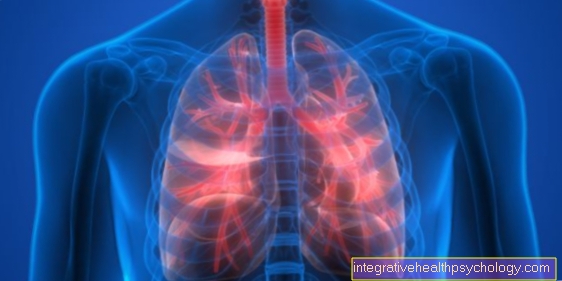
Lung cancer
Lung cancer is the second most common cancer in both women and men and the deadliest cancer in men. The development of lung cancer has not yet been conclusively clarified, but the most important risk factor is by far smoking. Over 90% of all lung cancer patients are or have been smokers. The first symptoms of lung cancer are usually a persistent and possibly bloody cough and weight loss. Since the lungs are well connected to the body's blood and lymph systems, metastases develop in the body comparatively quickly. Therefore, the prognosis of lung cancer is worse than that of other cancers. Surgical removal of the tumor as well as radiation and chemotherapy are used in therapy.
For details, see Lung cancer.
Pulmonary embolism
A pulmonary embolism is the blockage of a blood vessel that supplies the lungs (pulmonary artery). As a rule, this occlusion is caused by a blood clot that has been swept away, which occurs, for example, as part of a thrombosis in the leg and from there passes through the blood system to the lungs. This clot of blood is also known as an "embolus". The lung area, which is no longer supplied with blood because of the blood clot, can no longer "breathe" and therefore the oxygen supply to the body is endangered. A pulmonary embolism is therefore a very serious clinical picture that should definitely be treated as an inpatient. Around 20,000-40,000 people die of pulmonary embolism in Germany every year.
For more information, see Pulmonary embolism.
Pulmonary fibrosis
Lung fibrosis is a chronic disease in which the lung tissue is subject to connective tissue remodeling and thus loses its functionality. This makes the lungs less elastic and the exchange of oxygen is reduced. As a result, pulmonary fibrosis leads to shortness of breath, reduced performance and right heart failure.
More information is available here: The pulmonary fibrosis
Pulmonary edema
In simple terms, pulmonary edema is water in the lungs. This water mostly gets into the lungs because blood builds up in the lungs and water can pass from the blood system into the lung tissue. After the blood in the lungs becomes saturated with oxygen, the blood is passed on to the left heart. If there is a left heart failure (Heart failure), the left heart no longer pumps adequately and the blood backs up into the lungs. But also with a kidney weakness (Renal failure / renal insufficiency) pulmonary edema can occur as the body's water balance is generally too high and water can settle in the lungs. Most patients suffer from shortness of breath and chronic cough.
For details, see Pulmonary edema.
Pneumothorax
The word Pneumothorax means something like "air in the chest" in German. This air normally belongs in the lungs and not in the space between the lungs and the chest. A pneumothorax occurs when the lungs are damaged and air can travel from the lungs to the chest like a valve. These lung injuries can occur, for example, as part of an accident due to a broken rib, but also when a distended lung section (pulmonary emphysema) "bursts". Pneumothorax can also occur in the context of other underlying diseases such as pneumonia or lung cancer. For treatment, the air can be released from the chest cavity through a small incision between the ribs so that the lungs can fully expand again.
For more information, see Pneumothorax.
Rare lung diseases
Information on other rarer lung diseases can be found here:
- Cystic fibrosis
- Sarcoid
- Alpha-1 antitrypsin deficiency
- Hemothorax
- Bronchiectasis
- Atelectasis


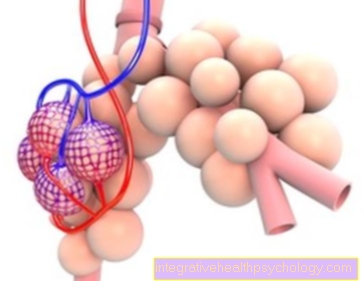









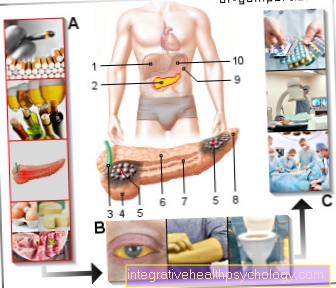





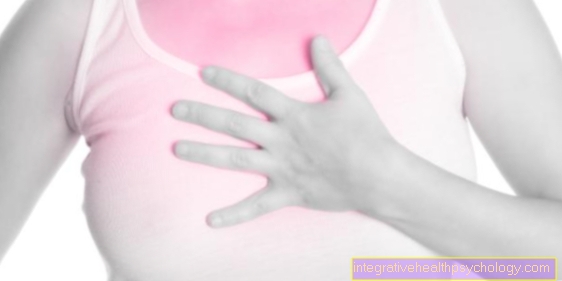




.jpg)





